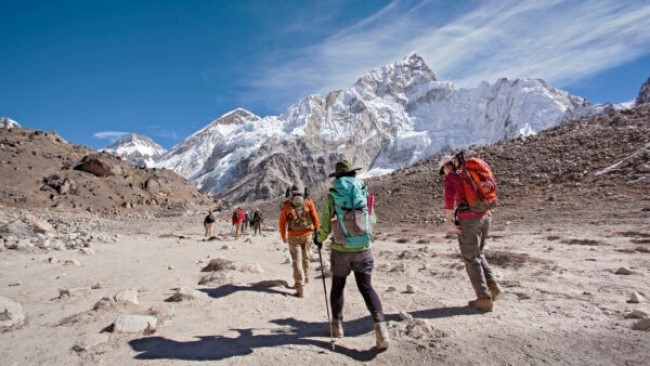Solo vs. Group Trekking: What’s Best for Your Everest Base Camp Trek Experience?

When planning an Everest Base Camp trek, one of the key decisions to make is whether to undertake the journey solo or as part of a group. Each option presents distinct advantages and challenges, and the choice ultimately depends on personal preferences, experience, and the type of experience one seeks.
Introduction: Everest Base Camp
Solo trekking offers a profound sense of independence and self-reliance. For experienced trekkers, the freedom to set your own pace, choose your route, and make spontaneous decisions can be incredibly rewarding. Solo trekkers often enjoy the opportunity for solitude and reflection, away from the hustle and bustle of guided groups. This personal journey allows for a deep connection with the landscape and a more intimate experience of the trek. However, solo trekking requires meticulous planning and preparation. Trekkers must be skilled in navigation, have a solid understanding of high-altitude trekking challenges, and be prepared to handle emergencies on their own. The Everest Base Camp trek, being remote and demanding, can pose significant risks, making thorough preparation essential.
In contrast, group trekking offers a structured and supportive environment. Joining a group trek, often organized by a trekking agency, provides the benefit of having experienced guides and support staff who handle logistics, route planning, and safety measures. This can be particularly advantageous for those new to high-altitude trekking or those who prefer not to navigate on their own. Group treks also foster camaraderie among participants, allowing for shared experiences and mutual encouragement, which can enhance the overall trekking experience. The sense of community and shared achievement often makes group trekking more enjoyable and less isolating. Additionally, having guides and porters can alleviate some of the physical and logistical burdens, allowing trekkers to focus more on the experience itself rather than on the details of the trek.
Choosing between solo and group trekking also involves considering safety and support. While solo trekkers must be prepared to manage potential risks independently, group trekkers benefit from the collective expertise and support of their fellow trekkers and guides. In the event of an emergency, a group is generally better equipped to provide assistance and facilitate evacuation if necessary.
Ultimately, the decision between solo and group trekking depends on individual preferences and trekking goals. Solo trekkers seeking a personal, self-directed adventure may find the solitude and independence rewarding. Conversely, those valuing shared experiences, structured support, and community may find a group trek more fulfilling. Regardless of the choice, both options offer unique and memorable ways to experience the majestic Everest Base Camp, each providing its own set of rewards and challenges.
Introduction to Trekking Options
When planning an Mount Everest Base Camp trek, choosing between solo and group trekking options is a crucial decision that shapes the overall experience. Solo trekking allows for an independent and personalized journey, while group trekking provides structure and support. Each option caters to different preferences and trekking goals, offering unique experiences and benefits. Solo trekkers relish the freedom to set their own pace and make spontaneous decisions, while group trekkers enjoy the camaraderie and assistance of fellow adventurers and guides. Understanding these options helps trekkers select the approach that best aligns with their expectations, level of experience, and desired trekking experience.
Benefits of Solo Trekking
Solo trekking offers a profound sense of freedom and personal accomplishment. It provides the opportunity for self-discovery and a deep connection with the natural environment, as trekkers navigate the trail independently. This autonomy allows for a personalized experience, where one can set their own pace, choose when and where to rest, and fully immerse themselves in the journey without external constraints. Solo trekkers often enjoy the solitude and peace of the trek, which can be both rejuvenating and introspective. The challenge of managing the trek alone can also enhance personal growth and self-reliance, as trekkers learn to handle various aspects of the journey, from navigation to emergency situations, on their own.
Challenges of Solo Trekking
Solo trekking comes with its own set of challenges, particularly on demanding trails like Everest Base Camp. One of the primary difficulties is the increased responsibility for safety and navigation. Solo trekkers must be adept at reading maps, using GPS, and handling potential emergencies without immediate assistance. This requires a high level of preparation and experience. The isolation of solo trekking can also be a disadvantage, as there is no built-in support network for encouragement or problem-solving. Additionally, managing logistical aspects such as food, accommodation, and permits falls entirely on the individual. The physical and mental demands of solo trekking can be significant, making it essential for trekkers to be well-prepared and self-sufficient.
Advantages of Group Trekking
Group trekking offers numerous advantages, particularly for those who prefer a more structured and supportive experience. One of the main benefits is the presence of experienced guides and support staff who handle logistics, safety, and route planning, allowing trekkers to focus on the journey itself. The camaraderie among group members can enhance the trekking experience, providing mutual encouragement and shared memories. Group treks also offer a sense of security, with multiple people available to assist in case of emergencies or difficulties. Additionally, joining a group can be a more socially engaging experience, providing opportunities to meet and bond with fellow trekkers from diverse backgrounds. The structured nature of group treks can also simplify planning and reduce individual responsibility.
Disadvantages of Group Trekking
While group trekking has many benefits, it also comes with potential drawbacks. One of the main disadvantages is the lack of flexibility; trekkers must adhere to a set itinerary and pace determined by the group. This can limit personal freedom and spontaneity, which some may find restrictive. Group dynamics can also be a challenge, as differing preferences and personalities may lead to conflicts or discomfort. Additionally, the presence of a larger number of trekkers can sometimes lead to overcrowding on the trails and at campsites, potentially detracting from the tranquility of the experience. Group trekking also involves sharing resources and accommodations, which may not always align with individual preferences or comfort levels.
Safety Considerations for Solo Trekkers
Safety is a paramount concern for solo trekkers on challenging routes like Everest Base Camp. One of the primary considerations is ensuring thorough preparation and having the skills to navigate and handle emergencies independently. Solo trekkers must be adept at using maps and GPS devices, understanding weather patterns, and recognizing signs of altitude sickness. It’s crucial to have a detailed plan, including emergency contact information and a clear itinerary, shared with someone who can track your progress. Carrying a well-stocked first aid kit, necessary medications, and emergency communication devices like a satellite phone or a personal locator beacon is essential. Additionally, solo trekkers should be prepared for unpredictable weather and be ready to turn back if conditions become hazardous. Building a high level of physical fitness and mental resilience is also important, as the journey can be physically demanding and emotionally isolating. Staying informed about local conditions and respecting safety guidelines helps mitigate risks and ensures a safer solo trekking experience.
Social Dynamics in Group Trekking
Social dynamics play a significant role in group trekking, influencing the overall experience of the journey. In a group setting, trekkers interact with diverse individuals, each bringing unique perspectives and personalities. This diversity can enhance the experience through shared stories, mutual support, and camaraderie. Positive group dynamics can lead to a more enjoyable and motivating trek, as trekkers encourage each other and work together to overcome challenges. However, managing group dynamics also involves navigating potential conflicts and differences in pace or preferences. Effective communication and flexibility are key to maintaining harmony within the group. Guides often play a crucial role in facilitating group cohesion, resolving disputes, and ensuring that the trek runs smoothly. Overall, while group trekking offers the benefits of social interaction and collective support, it requires adaptability and cooperation to ensure a cohesive and positive experience for all participants.
Cost Comparison: Solo vs. Group
The cost of trekking to Everest Base Camp can vary significantly depending on whether you choose to trek solo or join a group. Solo trekking generally requires a higher upfront investment in terms of permits, gear, and logistical arrangements. Solo trekkers must also cover all expenses for guides, porters, and accommodation independently, which can add up quickly. In contrast, group trekking often includes these costs as part of a package deal offered by trekking agencies, which can be more economical due to shared expenses and bulk arrangements. Group treks may also offer better value by including additional services such as meals, transport, and support staff. However, the cost of group trekking can vary depending on the quality and inclusiveness of the package. While solo trekking allows for more flexibility in spending and itinerary choices, group trekking provides a more predictable cost structure and can be more affordable when considering all-inclusive options.
Flexibility and Itinerary Planning
Flexibility and itinerary planning are key factors that differentiate solo and group trekking experiences. Solo trekkers enjoy the freedom to create and adjust their own itinerary, allowing for spontaneous changes based on weather conditions, personal energy levels, or new discoveries along the way. This flexibility enables a highly personalized trek, tailored to individual preferences and pace. Conversely, group treks follow a predetermined itinerary set by the trekking agency, which provides structure and ensures that key highlights are included. While this structured approach offers convenience and minimizes planning hassles, it limits the ability to make on-the-fly adjustments. Group trekkers must adhere to the collective schedule and pace, which can be less accommodating of personal preferences. The choice between solo and group trekking depends on whether you value the freedom to customize your journey or prefer the predictability and convenience of a pre-arranged itinerary.
Access to Local Knowledge and Guides
Access to local knowledge and guides is a significant advantage of group trekking, offering valuable insights and support throughout the journey. Professional guides are well-versed in the local terrain, weather conditions, and cultural practices, providing trekkers with expert advice and ensuring safety on the trail. They can offer detailed information about the route, local flora and fauna, and historical sites, enhancing the overall trekking experience. Guides also handle logistical aspects such as permit arrangements, accommodation bookings, and emergency procedures. In group treks, guides play a central role in managing group dynamics and maintaining a steady pace. Solo trekkers, while experiencing a high degree of independence, may lack immediate access to such specialized local knowledge. It is crucial for solo trekkers to conduct thorough research, possibly hire a local guide for specific segments of the trek, and remain informed about the region to compensate for the absence of on-the-ground expertise.
Personal Growth and Reflection
Both solo and group trekking offer profound opportunities for personal growth and reflection, though in different ways. Solo trekking provides an intense, introspective experience. Trekking alone through challenging terrain forces trekkers to confront their limits, navigate obstacles independently, and make critical decisions. This self-reliance fosters a deep sense of personal achievement and self-discovery, as trekkers reflect on their capabilities, fears, and aspirations. The solitude of solo trekking allows for uninterrupted contemplation, offering a chance to disconnect from daily routines and gain clarity on personal goals and values.
In contrast, group trekking facilitates personal growth through social interactions and teamwork. Navigating challenges as part of a group enhances communication skills, patience, and adaptability. The shared experience of overcoming obstacles and celebrating achievements together can strengthen interpersonal relationships and build a sense of community. This collaborative environment encourages trekkers to develop empathy, leadership, and conflict-resolution skills. Both solo and group trekking provide unique avenues for personal development, with solo trekking emphasizing internal growth and independence, while group trekking focuses on interpersonal dynamics and collective achievement.
Impact on the Trekking Experience
The choice between solo and group trekking significantly impacts the overall trekking experience. Solo trekking to Mount Everest Base Camp allows for a highly personalized adventure, where the trekker sets their own pace, chooses their route, and adjusts their itinerary based on personal preferences and conditions. This flexibility can lead to a more intimate and individualized experience, with opportunities for self-discovery and a deeper connection with the natural environment.
On the other hand, group trekking offers a structured experience with the benefits of collective support and shared camaraderie. The presence of guides and fellow trekkers provides a safety net, logistical support, and a built-in social network, which can enhance motivation and enjoyment. Group treks often follow a well-defined itinerary, ensuring that key landmarks and highlights are covered. While this structure provides less flexibility, it also reduces the burden of planning and can make the experience more accessible and enjoyable for those who prefer a more organized approach.
Choosing the Right Option for You
Choosing between solo and group trekking depends on individual preferences, experience level, and trekking goals. If you value independence, self-discovery, and the flexibility to customize your journey, solo trekking may be the ideal choice. It suits experienced trekkers who are comfortable with navigation and managing their own logistics. However, if you prefer a structured approach with the added support of guides and the camaraderie of fellow trekkers, a group trek might be more suitable. Group treks are beneficial for those who enjoy social interaction, seek a supportive environment, or prefer a well-organized itinerary. Assessing your comfort with navigating high-altitude conditions, your desire for personal reflection versus social engagement, and your budget will help determine which option aligns best with your trekking goals.
Tips for Successful Solo and Group Trekking
For solo trekkers, success hinges on meticulous preparation and self-reliance. Ensure you are physically fit, well-prepared for high-altitude conditions, and equipped with essential gear, navigation tools, and emergency supplies. Research the route thoroughly, share your itinerary with someone who can monitor your progress, and be prepared to adapt to changing conditions.
For group trekking, fostering a positive experience involves embracing teamwork and communication. Be open to the group’s pace and itinerary, engage with fellow trekkers, and respect the guidance of the trek leader. Preparation should include understanding the group’s schedule, packing according to the trek’s requirements, and maintaining flexibility to accommodate the group’s dynamics.
Both solo and group trekking require careful planning and a willingness to adapt, but with the right approach, each offers a rewarding and memorable experience on the Everest Base Camp trail.
Conclusion: Making an Informed Decision
Choosing between solo and group trekking for the Everest Base Camp adventure involves evaluating your personal preferences, experience level, and desired trekking experience. Solo trekking offers independence, flexibility, and a chance for profound personal reflection, while group trekking provides structure, support, and social interaction. By considering the benefits and challenges of each option, assessing your comfort with self-navigation versus reliance on guides, and aligning your choice with your trekking goals, you can make an informed decision that enhances your adventure. Regardless of the choice, both solo and group trekking offer unique and enriching experiences on the iconic Everest Base Camp trail, each catering to different aspects of personal and communal exploration.



